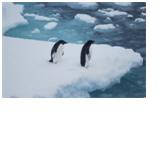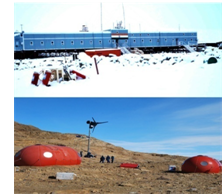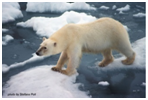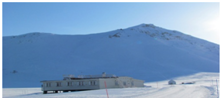POLAR RESEARCH
With a view to characterizing the contrasting features of the atmospheric aerosols between densely populated northern hemispheric continents and the pristine Antarctic environment with the least human impact, ARFI in collaboration with National Centre for Antarctic and Ocean Research (NCAOR), Goa, extended the footprints beyond boundaries by participating in the Antarctic and Arctic Expeditions.
Antarctic Expeditions


The last frontier is no more a clean and pristine environment. Extensive scientific observations on aerosol parameters were made over the Antarctic Ocean and continents during the 27th, 28th and 33rd Indian Scientific Expedition to Antarctica (ISEA) during 2007-08, 2008-09 and 2013-14 of IPY. The observations were made from Maitri (70°S, 12°E, 123 m amsl) and also from Bharati (69°S, 77°E, 48 m amsl, where the third Indian station has been commissioned recently).
Arctic Expeditions


While under ARFI, the southern ocean and Antarctic region have been explored for a few years in the past, the Arctic remained uninvestigated, despite the importance of this polar region. As such, taking advantage of the opportunity provided by the NCAOR, a collaborative program has been undertaken to explore the Arctic region. Thus, extensive measurements of aerosol properties were made from the Norwegian Arctic region (Ny-Alesund, 79°N, 12°E) during the 4th Indian Arctic Expedition (July August 2010). Since then, regular participation in the successive summer and winter phases of the Indian Arctic Expedition has been taken up. Data collection is now progressing and more than a year of data have been generated. This is the FIRST long term data from Arctic made by an Indian team for Arctic aerosol study. The experimental set up was made at a moderately elevated location (Gruvebadet) in Ny-Alesund which is free from the local anthropogenic activities and away from the Himadri station at Ny Alesund. During winter months, the strong pressure gradient pushes air northward and aerosols are transported into the Arctic from mid-latitude sources whereas the summer provides more pristine conditions to characterize the global background aerosol conditions.
Aerosol Cryosphere Interaction
- Deposition of absorbing aerosols (mainly BC and dust) on highly reflecting surfaces (like snow or ice) could reduce the surface albedo by absorbing more sunlight, which may exacerbate warming and glacier/ snow melting. Extensive field campaigns were carried out to understand the Black Carbon properties over the Himalayan and Polar (Arctic and Antarctic) regions and its implications on snow melting.
- Recent field campaigns to the glaciers and long-term measurements from high altitude stations are used to understand the BC induced snow albedo forcing over southern slopes of Himalayas. Following a synthesis of measurements from the Himalayan ARFINET stations with those during a scouting experiment to a glacier, and models of snow and ice, coupled with radiative transfer schemes, this study highlighted the overwhelming role of snow-albedo forcing over direct forcing; the effect being higher for aged snow than for fresh snow. This has revealed a complex dependence of absorbing aerosols in the snow, the snow microphysics and other processes in determining the impact - the first major step towards understanding the aerosol-cryosphere interactions.
- A chain of observatories has been identified over the Himalayas to make extensive investigations on aerosol-cryosphere interaction processes using in-situ data collected through field experiments.
